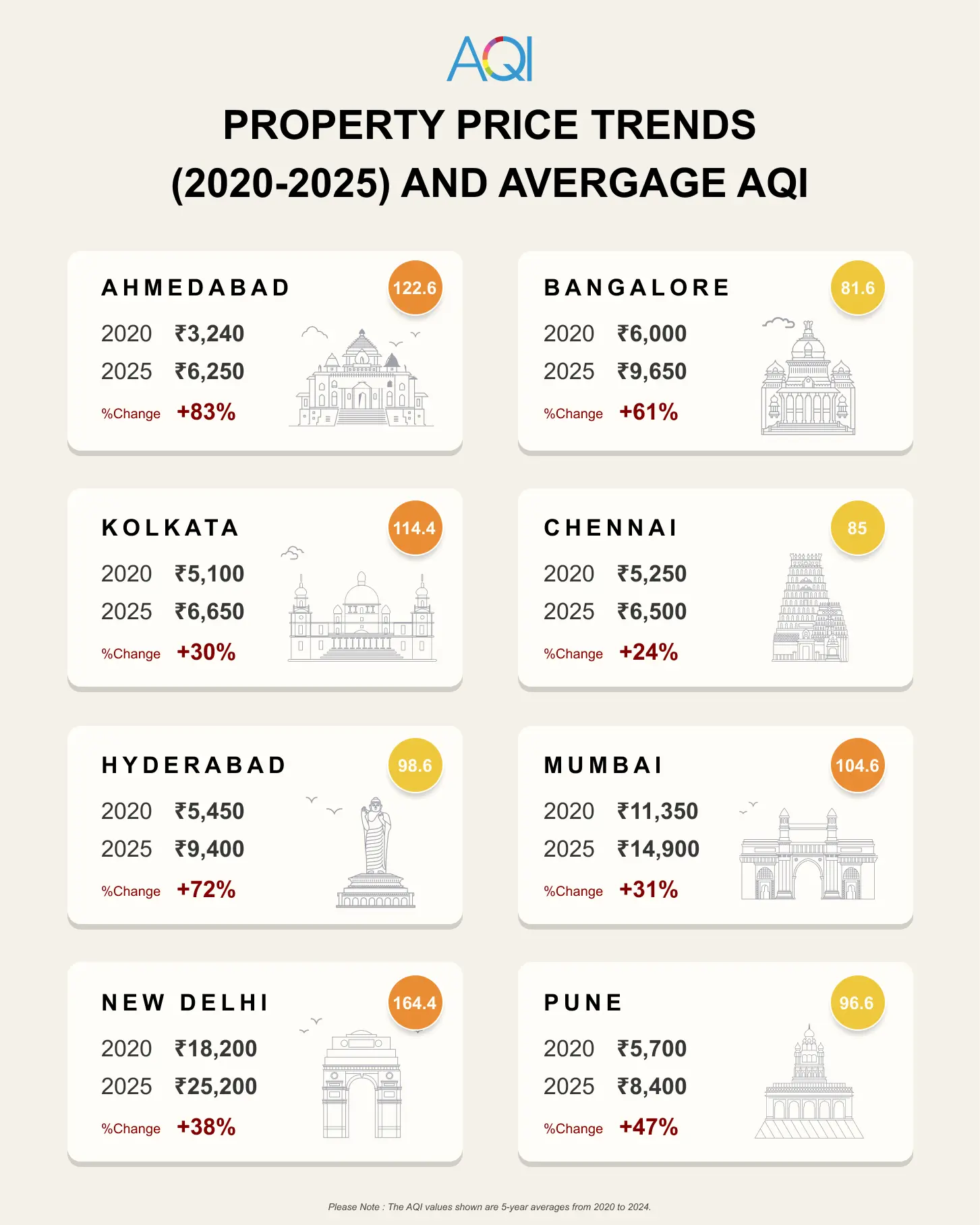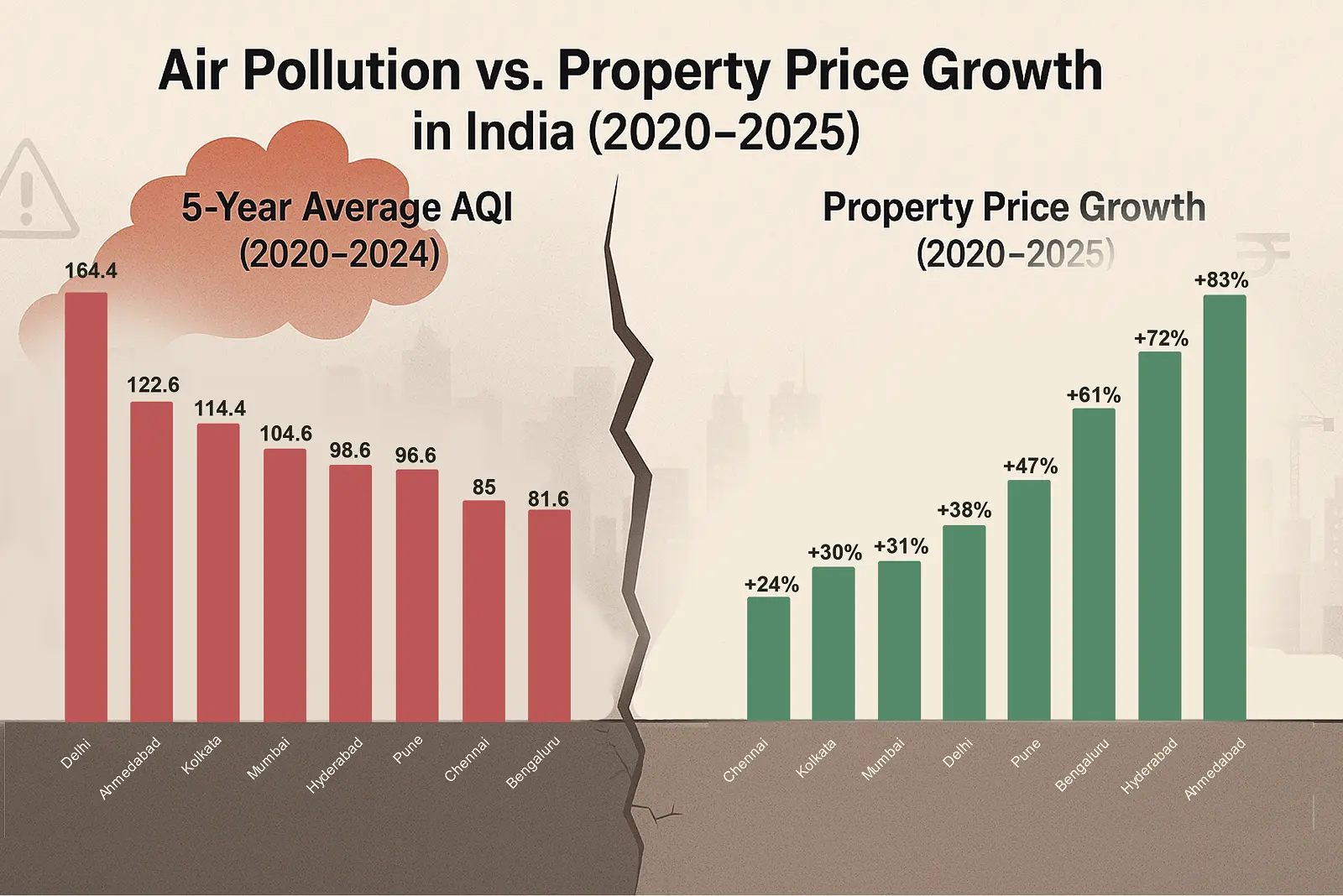Can you list important factors to buy a home? You may add location, price, services, amenities, interior and different things. These are the classic benchmarks that we all focus on, but have you ever considered the air quality of that area? I am sure the answer would be no, or maybe 1% of people would search for the air quality just because of their health issues, like asthma and other respiratory conditions. So, today’s topic is to know the impact of air pollution on property rates in India.
Cities like Delhi, Gurugram, and Noida regularly report AQI levels above 300, especially in winter, well into the “Hazardous” category. In contrast, cities like Bengaluru, Goa, and Kochi maintain annual averages below 80, a range considered “moderate” to “healthy.”
Logically, poor air quality should affect buyers and reduce property values in highly polluted cities. However, in India’s major Tier-1 cities, a completely different narrative is playing out. Despite consistently poor air quality, property prices are not only rising, they’re soaring. It’s a paradox that challenges conventional market wisdom.
To understand the two different narratives of AQI and real estate India, let us explore the air pollution data, property rates and what people are thinking. Through this, you can understand the reality behind air pollution impacting property prices in India. First, let us know what the residents’ notes are living in polluted areas like Delhi NCR.
The Hidden Reality: Only A few People Are Concerned About:
To understand the situation on the ground level, we have collected some past tweets from well-known social media platforms, Twitter (X) and Instagram.
First Post (Instagram)
“Should I flee Delhi or fight for it?”
These are the harsh words of Indian entrepreneur Ankur Warikoo, shared recently on Instagram. In his post, he expressed a dilemma that resonates with millions of urban families, especially parents. Amid rising pollution levels in the capital, he questioned whether raising his children in Delhi was a responsible choice.
“I feel like a bad parent,” he admitted, “for failing to give my kids access to clean air.”
The sentiment is echoed by others.
A viral tweet from @ivivek_nambiar reads:
“Pollution was intolerable. I had to get myself a mask. This day, I decided to leave Delhi for good. Moved to Kerala on May 31, 2020. I miss Delhi… but I remind myself of this photo, this day.”
These are just a few examples—the list goes on. While air quality is a concern for everyone, awareness is still limited, and the ability to move to a different city isn’t something most people can afford. After all, not everyone can leave behind their permanent home, job, or family. So, in the end, people are forced to ignore the very air they’re breathing.
Also, these thoughts reflect a larger urban anxiety brewing in India’s most populated cities. The concern is no longer just about smoggy skies or itchy eyes. It’s about what polluted air means for our health, our children, and even our property decisions. Now, let us know what the data of air pollution is narrating what story? Is air quality really that much worse in India?
Trend 2: A Tale of Air Quality in India 2020 to 2025:
| City | 2020 AQI | 2021 AQI | 2022 AQI | 2023 AQI | 2024 (YTD) |
| Delhi | 153 | 162 | 174 | 164 | 169 |
| Kolkata | 100(2 months missing) | 123 | 114 | 117 | 118 |
| Mumbai | 91 | 109 | 114 | 109 | 100 |
| Bengaluru | 86 | 84 | 87 | 78 | 73 |
| Hyderabad | 100 | 105 | 104 | 95 | 89 |
| Chennai | 86 | 81 | 85 | 90 | 83 |
| Ahmedabad | 124 | 130 | 117 | 123 | 119 |
| Pune | 64 (3 months missing) | 90 | 110 | 114 | 105 |
Want to access the historical data of these locations? Tap on the link here: My Location AQI
Source Note: This data is based on publicly available historical information. The values represent the annual average AQI, which smooths out daily and seasonal fluctuations, providing a consistent measure for year-on-year comparison of pollution exposure.
Key Observations from the Data:
These annual average AQI figures reveal a serious public health emergency in cities like Delhi, Kolkata, Mumbai, and Ahmedabad. But it’s not just these metros—none of the major Indian cities have recorded consistently “Good” or even “Moderate” air quality at any point over the past five years. If anyone believes this air is “acceptable,” it likely means they are alarmingly unaware—or unconcerned—about the dangers they’re breathing in every single day.
The reality is even more disturbing in North Indian cities, especially Delhi-NCR, which includes Noida, Gurugram, Greater Noida, Faridabad, and Ghaziabad. During the winter months, AQI levels in these areas regularly spike between 400 and 700, a range categorized as “Severe” to “Hazardous”. Long-term exposure to such levels is nothing short of a daily assault on your lungs, with potential lifelong consequences.
Trend 2: The Unstoppable Property Price in India (2020-2025)
Here’s a breakdown of the 5-year property price trends in India’s most polluted metros:
| City | Avg. Price Q1 2020 (₹/sq.ft.) | Avg. Price Q1 2025 (₹/sq.ft.) | % Change (2020–2025) |
| Greater Noida | ₹3,340 | ₹6,600 | +98% |
| Noida | ₹4,795 | ₹9,200 | +92% |
| Gurugram | ₹6,150 | ₹11,300 | +84% |
| Delhi | ₹18,200 | ₹25,200 | +38% |
| Hyderabad | ₹5,450 | ₹9,400 | +72% |
| Bengaluru | ₹6,000 | ₹9,650 | +61% |
| Mumbai (MMR) | ₹11,350 | ₹14,900 | +31% |
| Pune | ₹5,700 | ₹8,400 | +47% |
| Ahmedabad | ₹3,420 | ₹6,250 | +83% |
| Kolkata | ₹5,100 | ₹6,650 | +30% |
| Chennai | ₹5,250 | ₹6,500 | +24% |
Key Observation on Property Price Surge in India from 2020 to 2025:

This table exposes a clear contradiction: cities like Greater Noida, Noida, Gurugram, and Ahmedabad—frequent offenders in terms of high AQI levels—have posted price growth between 80% and 98%, making them some of the hottest real estate markets in India.
Even Delhi, despite being globally infamous for its air pollution, saw a 38% rise in average home prices. Hyderabad and Bengaluru, although slightly better off in terms of air quality, also reported steep increases in real estate value.
The numbers send a strong message on air quality and property value: the market demand remains largely disconnected from environmental concerns. While investors chase capital appreciation, and homebuyers prioritise location and infrastructure, air quality remains an under-prioritised factor—even in cities where the air is visibly unbreathable.
Decoding the two different Narratives: Why impact of air pollution on property rates in India not visible?
As both sets of data show, air quality levels have either worsened or remained stuck in the “poor” category over the last five years. At the same time, property prices in India are soaring to new heights. To make sense of these two contrasting trends, we’ve identified a few key factors that deserve everyone’s attention.

The most critical point? Lack of awareness about air pollution, especially among people living in the most affected areas. Many residents simply don’t realize the long-term damage polluted air can cause to their health and quality of life.
But here’s the question:
Why are people still paying a premium to live in cities where the air they breathe could shorten their life expectancy? The answer lies in a complex mix of economic necessity, rapid urban development, and shifting buyer psychology.
1. Better Employment Opportunities – The Corporate Magnet
India’s most polluted cities are also economic powerhouses. Cities like Delhi-NCR, Mumbai, Hyderabad, and Bengaluru are hubs for IT, finance, manufacturing, and service sectors. People from smaller towns and rural areas are constantly moving to these cities in search of better job opportunities.
At the end of the day, good air can’t replace a good paycheck, and for most, economic survival outweighs environmental concerns.
2. Infrastructure = Value Growth
Real estate follows development. And over the past five years, these cities have witnessed massive infrastructure growth, including:
- New metro corridors
- High-speed expressways like the Delhi–Mumbai Expressway and the Purvanchal Expressway
- Expanding airport networks, such as Indira Gandhi International Airport (IGI) and the upcoming Noida International Airport
All these projects boost accessibility, attract investors, and drive up property values—even in areas where pollution levels are dangerously high. Again, this highlights a hard truth: for many, easy commuting and location convenience matter more than the air they’re breathing every day.
3. Where the Money Flows, Prices Climb
Let’s be real—cities like Delhi-NCR, Mumbai, and Bengaluru are still the top picks for investors. Whether it’s NRIs looking for safe bets, big institutional funds, or private developers chasing growth, money continues to pour into these cities.
And what happens when money flows in? Demand rises fast, projects get sold out quickly, and prices shoot up—even if the air quality is terrible. Pollution takes a back seat when capital is leading the way.
4. A Silent Shift: People Are Starting to Move for Cleaner Air
While big metros are still booming, something interesting is happening on the side. A slow but steady shift is happening among health-conscious people actively looking for cleaner air and greener homes.
- Cities like Dehradun, Kochi, and Mysuru are suddenly popping up on real estate radars.
- In polluted metros like Delhi and Mumbai, developers are now adding features like air purification systems, green rooftops, and wellness amenities just to attract this new group of buyers.
However, this leverage is present for the higher societies those who can afford the luxury to breathe the clean air in the most polluted cities.
Conclusion
The numbers don’t lie—India’s most polluted cities are expanding rapidly, and so are their property prices. But beneath this rise is an overlooked truth: the impact of air pollution on property rates in India is real, yet not widely understood.
As awareness grows, more homebuyers are starting to ask deeper questions—not just about affordability and location, but about long-term health and livability. If you’re planning to invest in real estate, don’t just look at price per square foot. Ask yourself: What’s the air quality I’ll be living in?
Call to Action
Before making your next big move, check the AQI of the area on trusted platforms like AQI.in. Your future home should offer more than walls and amenities—it should offer clean air and a healthier life. Because the impact of air pollution on property rates in India isn’t just economic—it’s personal.